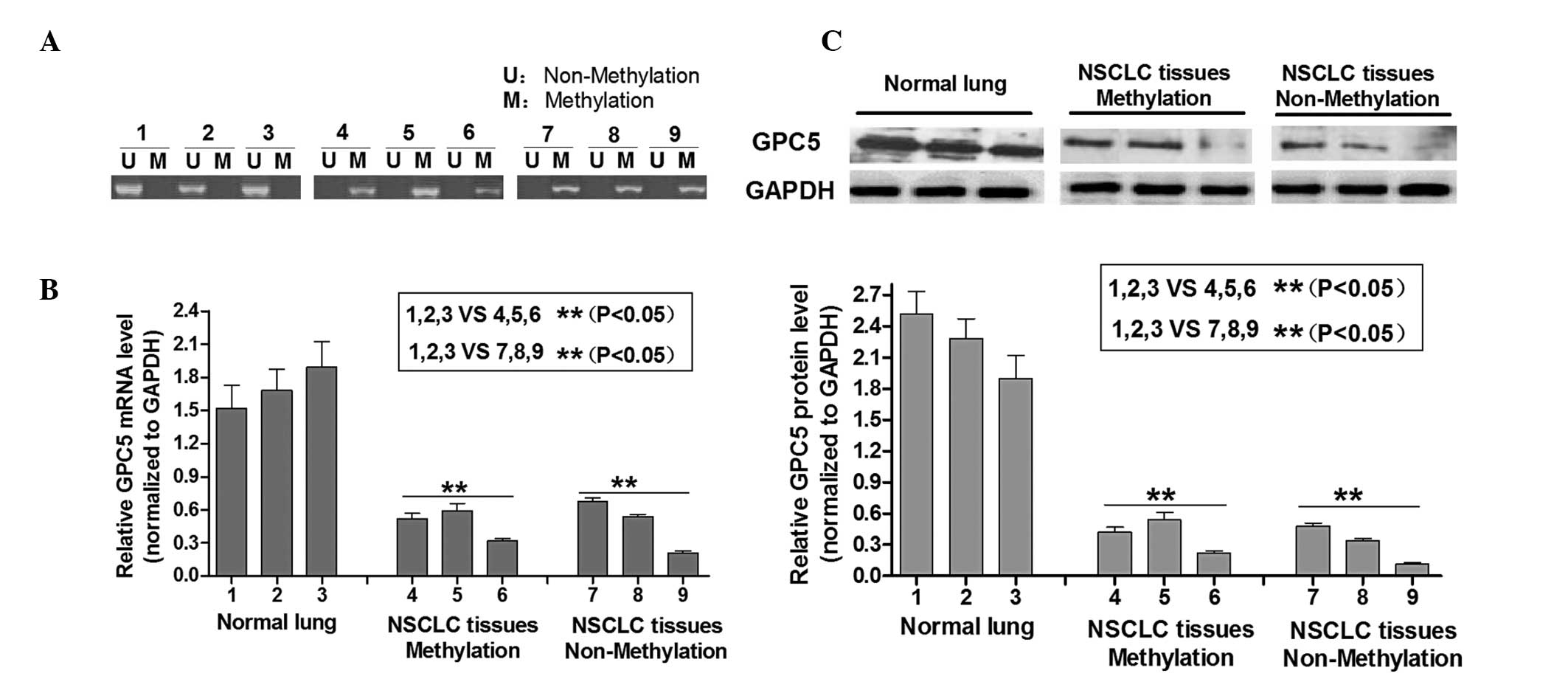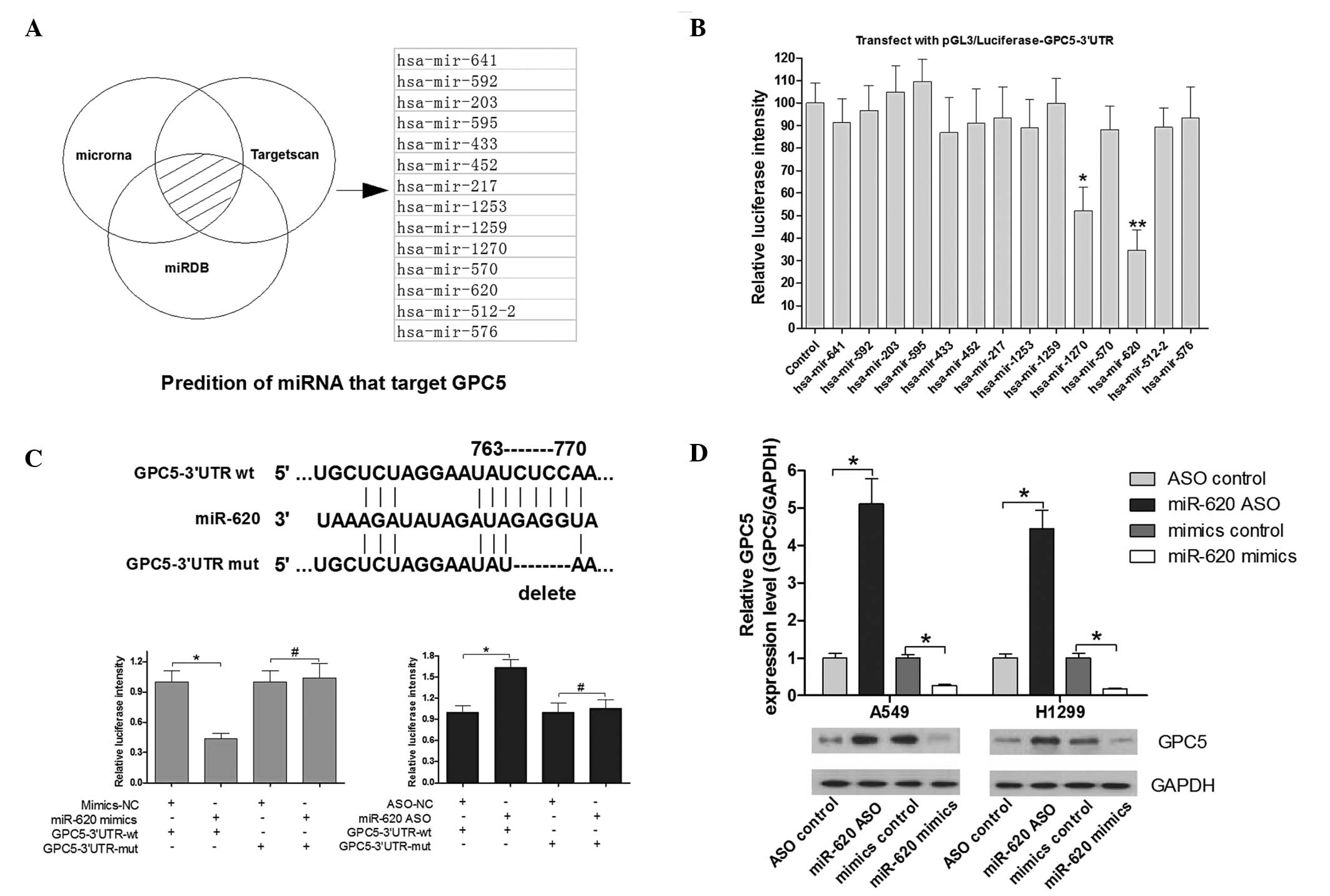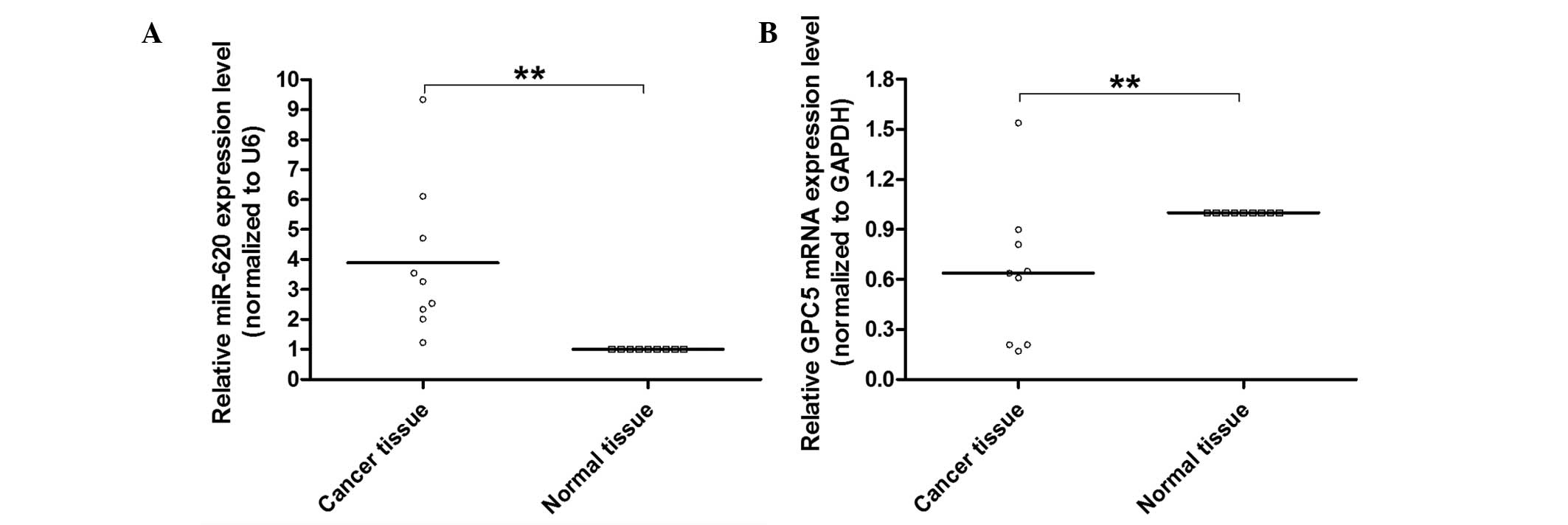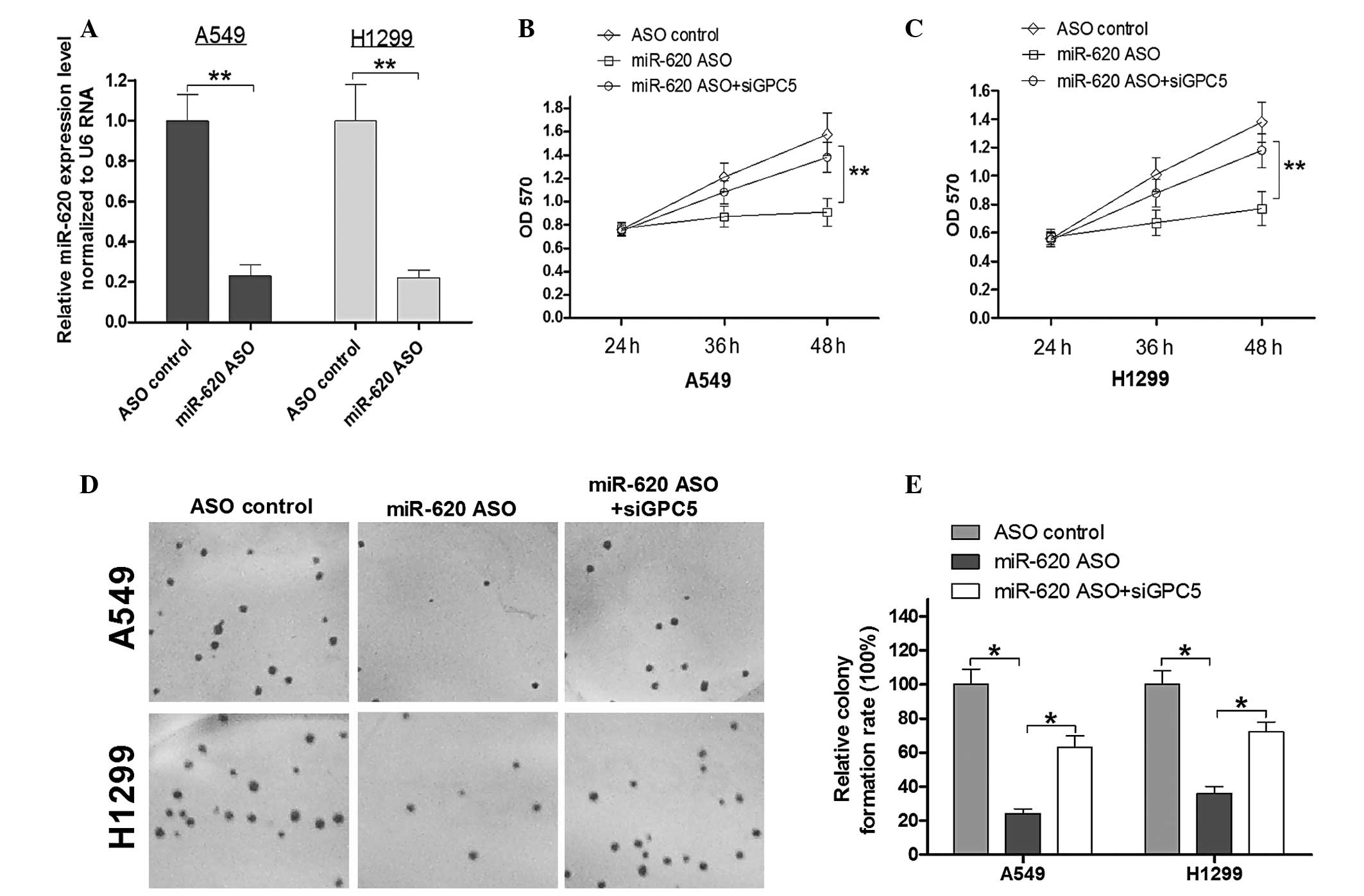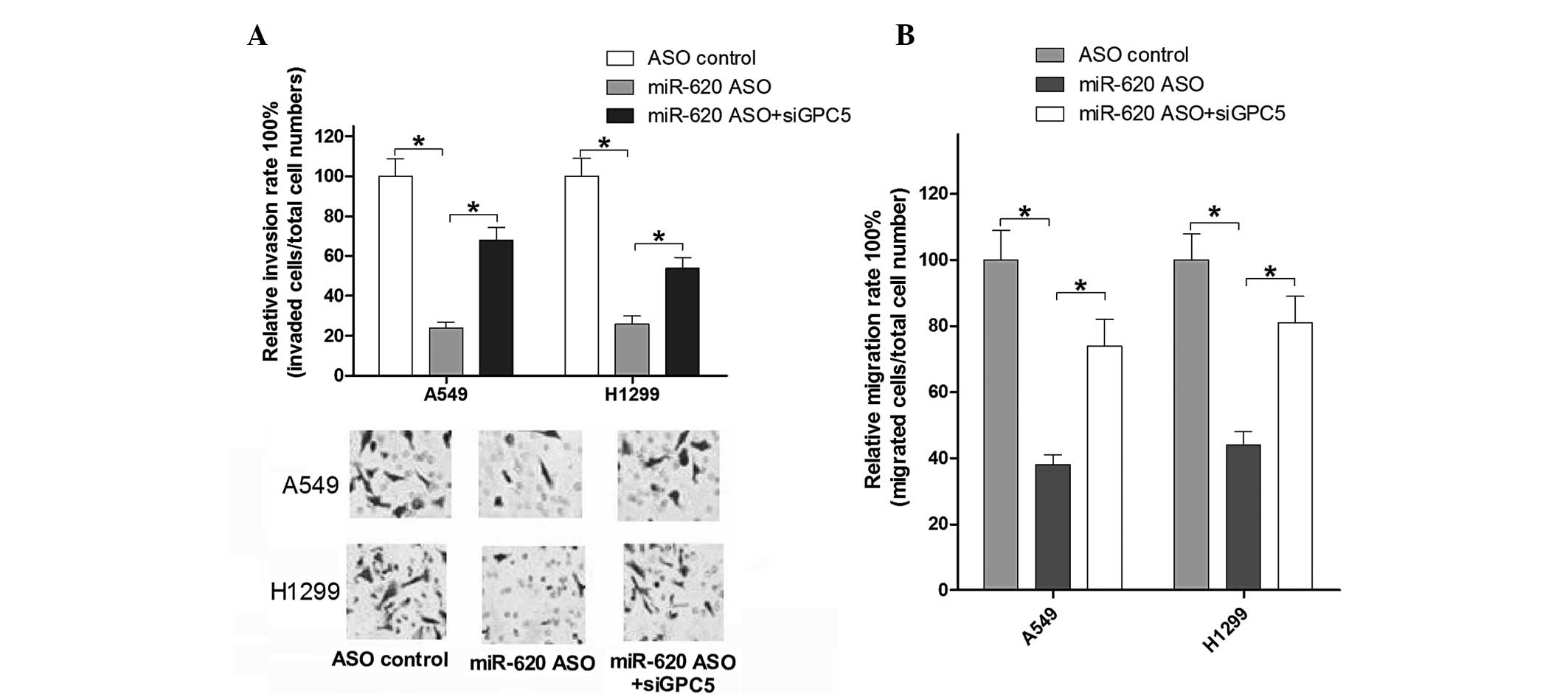GPC5, a tumor suppressor, is regulated by miR‑620 in lung adenocarcinoma
- Authors:
- Published online on: March 28, 2014 https://doi.org/10.3892/mmr.2014.2092
- Pages: 2540-2546
Abstract
Introduction
Lung cancer is the leading cause of cancer-associated mortality worldwide, and it occurs more frequently in males compared with females. Despite recent advances in clinical and experimental oncology, the prognosis of lung cancer remains unfavorable, with a 5-year overall survival rate of ~11%, threatening human health (1,2). Thus, a detailed understanding of the mechanisms underlying lung cancer development and progression are essential for improving the diagnosis, prevention and treatment of this disease.
Recently, a five-center collaborative study (3) reported that genetic variants at 13q31.3 alter GPC5 expression and are associated with susceptibility to lung cancer in non-smokers. GPC5 gene expression levels in normal lung tissues were found to be significantly lower in individuals who carry high-risk alleles, and that the GPC5 expression level in adenocarcinoma tissue was significantly lower compared with matched normal lung tissue. Reduction of the expression of GPC5 may lead to the development of lung cancer, suggesting that this gene normally functions as a tumor suppressor.
MicroRNAs (miRNAs) are a family of endogenous, small non-coding, ~22 nucleotide RNA molecules, which bind to the target gene mRNA through complete or incomplete complementarity with its 3′-untranslated region (3′-UTR), leading to target mRNA degradation or translational repression (4). To date, ~60% of the protein-coding genes are regulated by miRNAs and a large number of studies show that miRNAs are involved in specific biological processes, including cell growth, apoptosis and differentiation (5–8). In the current study, epigenetic silencing by hypermethylation of the CpG-rich region of GPC5 was observed to lead to loss of GPC5 function, and the roles of miRNAs in the reduction of GPC5 in lung adenocarcinoma were explored. TargetScan, miRDB, and www.microrna.org were used to predict biological targets of miRNAs, and a series of miRNAs were found to target the 3′-UTR of GPC5. The luciferase assay verified that miR-620 directly targets the 3′-UTR of GPC and regulates its expression in A549 and H1299 lung adenocarcinoma cells. Further in vitro assays indicate that knockdown of the expression of GPC5 with GPC5 small interfering (si)RNA rescues the changed phonotype of lung adenocarcinoma cells caused by miR-620. Finally, the GPC5 expression level was observed to be negatively associated with miR-620 expression in lung cancer tissue. These results suggest that miRNA regulating GPC5 expression may be important in the development of lung adenocarcinoma and, which may in turn lead to carcinogenesis.
Materials and methods
Clinical samples and cell lines
A total of nine matched lung adenocarcinoma and adjacent normal human lung tissues used in the current study were obtained from the Pingjin Hospital, (Tianjin, China). Specimens were snap-frozen in liquid nitrogen. The collection and use of the patient samples were reviewed and approved by Pingjin Hospital Institutional Ethics Committees, and written informed consent from all patients was appropriately obtained. The characteristics of the patients with lung cancer is presented in Table I. A549 and H1299 cells were purchased from the American Type Culture Collection (Manassas, VA, USA). The A549 and H1299 cells were cultured at 37°C in 5% CO2 in RPMI-1640 media (Gibco-BRL, Grand Island, NY, USA) supplemented with 10% fetal bovine serum (FBS). A549 and H1299 cells were transfected with Lipofectamine 2000 reagent (Invitrogen Life Technologies, Carlsbad, CA, USA). Enriched small RNAs were extracted using the mirVana™ miRNA isolation kit (Ambion, Austin, TX, USA). Total RNA was extracted using TRIzol reagent (Invitrogen Life Technologies).
Selection of candidate miRNAs
The candidate miRNAs selected to bind to GPC5 were identified using three web-based bioinformatic algorithms. TargetScan, miRDB and microRNA predict miRNA-binding sites based on complementary nucleotide sequences in the 3′-UTR of GPC5 mRNA.
Luciferase reporter assay
Plasmids containing GPC5-3′-UTR and GPC5-3′-UTR mutation were constructed using technical support from Dajin Company (Guangdong, China). The 3′-UTR sequence of GPC5, predicted to interact with miR-620 and a mutated sequence of the 3′-UTR sequence by three miRNA target prediction algorithms, was inserted into pGL3 vectors (Promega Corporation, Madison, WI, USA). Following transfection of miR-620 or miR-620 (antisense oligonucleotide) ASO for 24 h, A549 cells were transfected with pGL3/GPC5-3′-UTR and pGL3/GPC5-3′-UTR mutant plasmids. Following 48 h, the luciferase activity of A549 cells was measured 96 h after transfection using the Dual-Luciferase reporter assay system (Promega Corporation).
Cell growth assay
Cells were seeded in 96-well plates at 8,000 cells/well and transfected the following day. The MTT assay was used to determine relative cell growth 24, 48 and 72 h following transfection. MTT solution (20 μl) was added to 100 μl culture media and cells were incubated for a subsequent 4 h at 37°C. Next, the optical density was measured at 570 nm (A570) by Bio-Rad 680 Microplate reader (Bio-Rad, Hercules, CA, USA).
Colony formation assay
The cells were seeded into a 12-well plate at a density of 200 cells/well following transfection. The medium was changed every three days. Approximately 10 days later, the majority of the cell clones contained >50 cells. The clones were washed with 1X phosphate-buffered saline and stained with crystal violet for ~5 min. Finally images were captured of the clones by a Canon camera (Cannon, Taiwan, China) and clones were counted. The colony formation rate was calculated to = (number of clones)/(number of seeded cells) × 100%.
Transwell invasion and migration assay
The cell invasion and migration ability was performed using the Transwell chamber with or without Matrigel (Millipore, Billerica, MA, USA). The transfected cells were plated into the upper chamber with 250 μl serum-free medium, while the lower chamber was filled with 750 μl cell medium with 10% FBS. The cells were allowed to invade for ~20 h, and were then washed, fixed and stained with 5% crystal violet. The cells, which did not invade into the membrane were scraped with cotton tips. Finally, images were captured of the invaded or migrated cells and cell numbers were counted by microscopy (Olympus, Tokyo, Japan).
Quantitative polymerase chain reaction (qPCR) analysis and western blotting
The total RNA, including miRNA was isolated using the TRIzol reagent according to the manufacturer’s instructions. The RNA concentration was determined using a NanoDrop-1000 spectrophotometer (Thermo Scientific, Waltham, MA, USA). For the reverse transcription reaction of the miRNA, specific miRNA RT primers were used (miR-620:5′-CTCAACTGGTGTCGTGGAGTCGGCAATTCAGTTGAGGAGCTTTA-3′). RNU6B (U6 small nuclear B non-coding RNA) was used as an internal control. The qPCR was performed using the SYBR-Green PCR Master mix (Applied Biosystems, Foster City, CA, USA) according to the following conditions: 95°C for 5 min followed by 40 cycles of amplification at 95°C for 30 sec, 57°C for 30 sec and 72°C for 30 sec. The cells were plated into a 6-well plate at a density of 3×104 cells/well and transfected on the second day when the cell confluency reached ~80%. At 48 h after transfection, the cells were lysed by RIPA buffer (50 mM Tris-HCl, pH 8.8, 150 mM NaCl, 1% NP-40, 1% sodium deoxycholate and 0.1% SDS) for 30 min at 4°C. The protein concentration was measured using the bicinchoninic acid (Haoran Bio Technologies Co., Ltd., Shanghai, China) assay method. The primary antibody was rabbit monoclonal anti-GPC5 antibody (1:200 dilutions) and anti-GAPDH antibody (1:1,000 dilutions; both Abcam, Cambridge, MA, USA). The secondary antibody was goat anti-rabbit IgG conjugated with horseradish peroxidase at a dilution of 1:1,000. The bound antibodies were detected with the use of Enhanced Chemiluminescence Plus Western Blotting Detection system (GE Healthcare, Buckinghamshire, United Kingdom) and the chemiluminescent signals were detected with the use of high-performance chemiluminescence film (GE Healthcare). GAPDH was used as an internal control to normalize GPC5 levels.
DNA methylation analysis
A total of 1 μg genomic DNA was treated with sodium bisulphite using the EZ DNA methylation™ kit (Zymo Research, Irvine, CA, USA), and subsequently analyzed for GPC5 methylation by the MethyLight technique (9).
Statistical analysis
Data are expressed as the mean ± standard deviation, and a Students-Newman-Keuls post hoc test was performed. P<0.05 was considered to indicate a statistically significant difference. All data were analyzed with SPSS 17.0 (SPSS Inc., Chicago, IL, USA) to confirm the statistical significance.
Results
Downregulation of GPC5 in lung adenocarcinoma cells is independent of DNA methylation
A total of nine lung adenocarcinoma tissues were analyzed by methylation-specific PCR (MSP) to detect the methylation status of the GPC5 CpG islands. As shown in Fig. 1A, tumors 1, 2 and 3 were unmethylated at the GPC5 CpG islands, whereas 4, 5, 6, 7, 8 and 12 were fully methylated at this locus (Fig. 1A). Next, the expression levels of GPC5 protein were determined in unmethylated and methylated lung adenocarcinoma tissues. Fig. 1B shows that the GPC5 mRNA and protein levels exhibited a loss of expression in the lung adenocarcinoma tissues compared with the normal lung tissues irrespective of the methylation status in CpG islands. Western blotting results showed that regardless of whether GPC5 CpG islands were methylated or not, the GPC5 protein was consistently expressed at a lower level in laryngeal carcinoma tissues compared with normal lung tissue, which was normalized to GAPDH (Fig. 1C). These results indicated that GPC5 was downregulated in lung adenomacarcinoma cells, which is consistent with a previous study (3) that implies that there may be another potential mechanism attributed to its downregulation.
miR-620 targets GPC5 transcription and downregulates its expression
TargetScan, microRNA and miRDB were selected for miRNA prediction. As shown in Fig. 2A, 14 candidate miRNAs were identified. To determine which miRNA is the most effective in regulating GPC5, a luciferase reporter assay was performed. A549 cells were transfected with the reporter vector along with the 14 miRNA mimics. Notably, miR-620 significantly downregulated luciferase intensity of pGL3/luciferase-GPC5-3′-UTR, and miR-1270 was also downregulated to a lesser extent (Fig. 2B). Thus, miR-620 was observed in regard to the regulation of GPC5. To further determine whether miR-620 directly regulates GPC5, another luciferase-reporter assay was used to validate the target site in the GPC5-3′-UTR (Fig. 2C). A549 cells were transfected with the reporter vector along with miR-620 mimics, control mimics, miR-620 ASO or control ASO. Notably, the intensity of luciferase in cells transfected with miR-620 mimics was significantly decreased compared with that in control cells, whereas the intensity of luciferase in cells transfected with miR-620 ASO was significantly increased (Fig. 2C). By contrast, the luciferase intensity from the reporter vector containing the mutant GPC5-3′-UTR was not affected by miR-620 mimics or miR-620 ASO (Fig. 2C). These results indicate that GPC5 is a direct target of miR-620. Furthermore, the effect of miR-620 on the expression of endogenous GPC5 was examined by western blot analysis. The GPC5 protein level was increased by ~5-fold in A549 and 4-fold in H1299 cells transfected with miR-620 ASP when compared with the control group (Fig. 2D). The GPC5 protein level was decreased by ~80% in A549 and 85% in H1299 cells transfected with miR-620 mimics when compared with the control group (Fig. 2D).
GPC5 expression level is inversely associated with miR-620 levels in human lung adenocarcinoma tissues
To further explore whether miR-620 regulates GPC5 expression in lung adenocarcinoma, the levels of miR-620 and GPC5 were examined in nine human lung adenocarcinoma tissues. qPCR was performed to detect miR-620 and GPC5 mRNA. As shown in Fig. 3A and B, the expression of miR-620 was inversely associated with GPC5 in the examined lung adenocarcinoma tissue, further indicating that miR-620 may have an important role in the reduction of GPC5 in lung adenocarcinoma tumorigenesis.
miR-620/GPC5 signal regulates the growth of human lung adenocarcinoma cells
To determine the role of miR-620 and GPC5 in the proliferation of lung adenocarcinoma cells, miR-620 ASO was used to block endogenous miR-620 expression in the A549 and H1299 lung adenocarcinoma cell lines. The efficiency of ASO-mediated blocking of miR-620 was confirmed by qPCR (Fig. 4A). An MTT assay and colony forming assay were used to determine the effects of miR-620 in lung adenocarcinoma cells. The optical density (OD)570 means in each group (Fig. 4B) indicated that transfection of A549 cells with miR-620 ASO resulted in the suppression of A549 cell proliferation 48 h post-infection when compared with the controls. To confirm whether the A549 growth alters with miR-620, ASO was mediated by GPC5, and a specific siRNA (siGPC5) was used to knockdown GPC5 expression. As expected, the cell viability was rescued by siGPC5 compared with the viability in the miR-620 ASO group. Thus, miR-620 regulates A549 cell proliferation by regulating GPC5 expression. A similar trend was observed in the H1299 cells (Fig. 4C). Next, the colony forming ability in the transfected A549 and H1299 cells was determined. The colony formation ability of A549 and H1299 cells were reduced to ~78 and 60%, respectively, in the miR-620 ASO group. A549 and H1299 cells simultaneously transfected with miR-620 ASO and siGPC5, exhibited rescued colony forming ability compared with the miR-620 ASO group with a statistical significance (Fig. 4D and E). This implied that the miR-620/GPC5 signal regulates cell growth in human lung adenocarcinoma.
miR-620/GPC5 signal regulates the invasion and migration of human lung adenocarcinoma cells
To further investigate the effect of miR-620/GPC5 signal on cell motility, Transwell invasion and migration assays were measured post-infection for 24 h in A549 and H1299 cells. As shown in Fig. 5A and B, the results suggested that blocking miR-620 suppressed the cell migration and invasion abilities in A549 cells, and similar results were obtained in H1299 cells. siGPC5 rescued the changed migration and invasion ability of A549 and H1299 cells compared with that in the miR-620 ASO group. These data investigated whether miR-620/GPC5 signal regulates the invasion and migration of human lung adenocarcinoma cells.
Discussion
GPC5 is a member of the glypican family, a group of membrane-bound heparan sulfate proteoglycans (HSPGs) that are linked to the exocytoplasmic surface of the plasma membrane via a glycosylphosphatidylinositol anchor (GPI). To date, six glypicans have been identified in mammals (GPC1 to GPC6) (10–14). These proteins have been suggested to be dysregulated in various types of cancer, including GPC1, which is overexpressed in human pancreatic and breast cancers (15,16), GPC3 is overexpressed in neuroblastoma, Wilm’s tumors, and melanoma (17,18). Alterations at the GPC5 locus are also a common event in various human tumors, including lymphomas, breast cancers, and neurological tumors (19–21). In lung cancer, GPC5 has been reported to be downregulated in adenocarcinoma tissue compared with matched normal lung tissue (3). Although epigenetic silencing by hypermethylation of the CpG-rich region of GPC5 leads to a loss of GPC5 function and carcinogenesis, the current study indicated that there remains a proportion of lung adenocarcinoma tissue with a lower expression level of GPC5 without DNA methylation. Thus, the current study aimed to further explore the other factors involved in the regulation of GPC5. Notably, following screening, 14 candidate miRNAs were selected that may target GPC5 and are involved in the reduction of GPC5 in lung adenocarcinoma. The luciferase reporter assay confirmed that miR-620 may have the most potential.
Hundreds of miRNAs have been reported to repress tumor suppressor genes, and this may be a common mechanism involved in tumorigenesis of lung cancer. Du et al (22) reported regulated expression of the tumor suppressor gene FUS1 in non-small cell lung cancer. Liu et al (23) demonstrated that miR-21 promotes growth, metastasis and chemoresistance or radioresistance in non-small cell lung cancer cells by targeting the tumor suppressor gene PTEN. miR-221 and miR-222 induces TRAIL resistance and enhances cellular migration through the activation of the AKT pathway and metallopeptidases by targeting the tumor suppressors PTEN and TIMP3 in lung cancer (24). Another important miRNA cluster miR-17–92, has been observed to be overexpressed in lung cancer and to target the tumor suppressors PTEN and Rb2 (25,26). These results suggest that a number of miRNAs are important in lung cancer progression and development, acting as oncogenes by regulating tumor suppressor gene expression. In the current study, miR-620 was observed to be upregulated in human adenocarcinoma compared with the adjacent normal tissues, which acts as an oncogene by regulating the tumor suppressor GPC5 in lung adenocarcinoma. Transfection of A549 and H1299 cells with miR-620 ASO was further shown to significantly induce growth, invasion and migration inhibition by MTT, colony formation assays, Transwell invasion and migration assays. Knockdown of GPC5 expression using GPC5-siRNA partly restores phenotype changes in A549 and H1299 cells. These results confirmed that miR-620 is involved in the tumorigenesis of lung adenocarcioma by repression of the tumor suppressor gene, GPC5.
In conclusion, the current study is summarized by several major findings: i) A downregulation of GPC5 in lung adenocarcinoma is observed irrespective of its methylation in the CpG region; ii) to the best of our knowledge, we have shown for the first time that miR-620 directly targets GPC5 and downregulates the expression of GPC5 in lung adenocarcinoma cells; and iii) the suppression of miR-620 using miR-620 ASO causes a marked inhibition of proliferation, invasion and migration in A549 and H1299 lung adenocarcinoma cell lines, and this phenotype is rescued by GPC5 knockdown. These results provide evidence that, in addition to hypermethylation, GPC5 may also be inactivated in lung adenocarcinoma cells by miR-620 overexpression. Further studies should be performed as follows: i) Since the expression patterns of GPC5 in different types of cancer are varied, including negative expression in acute lymphoblastic leukemia, histiocytic lymphoma and myeloma (27), and positive expression in lymphomas (28), further studies are required to evaluate the function of GPC5 in other tumors. ii) Based on the evidence that one miRNA regulates numerous target genes, and one tumor suppressor gene may be regulated by a number of miRNAs, studies are required to detect more miRNAs, including miR-1270, which regulates GPC5 expression to establish the miRNA/GPC5 regulation network for characterization of the progression of lung adenocarcinoma and iii) although the current study identifies the expression patterns of miR-620 in lung adenocarcinoma and clarifies the miR-620/GPC5 signal in tumorigenes of lung adenocarcinoma, further studies should aim to determine whether the mechanism of miR-620/GPC5 signaling contributes to the tumorigenesis of other cancers, and determine the expression patterns of miR-620 in other cancers.
References
|
Subramaniam S, Thakur RK, Yadav VK, Nanda R, Chowdhury S and Agrawal A: Lung cancer biomarkers: State of the art. J Carcinog. 12:32013. View Article : Google Scholar | |
|
Amorin Kajatt E: Lung cancer: a review of current knowledge, diagnostic methods and therapeutic perspectives. Rev Peru Med Exp Salud Publica. 30:85–92. 2013.(In Spanish). | |
|
Li Y, Sheu CC, Ye Y, et al: Genetic variants and risk of lung cancer in never smokers: a genome-wide association study. Lancet Oncol. 11:321–330. 2010. View Article : Google Scholar : PubMed/NCBI | |
|
Bartel DP: MicroRNAs: genomics, biogenesis, mechanism, and function. Cell. 116:281–297. 2004. View Article : Google Scholar : PubMed/NCBI | |
|
Brennecke J, Hipfner DR, Stark A, Russell RB and Cohen SM: Bantam encodes a developmentally regulated microRNA that controls cell proliferation and regulates the proapoptotic gene hid in Drosophila. Cell. 113:25–36. 2003. View Article : Google Scholar : PubMed/NCBI | |
|
Xu P, Vernooy SY, Guo M and Hay BA: The Drosophila microRNA Mir-14 suppresses cell death and is required for normal fat metabolism. Curr Biol. 13:790–795. 2003. | |
|
Ambros V: The functions of animal microRNAs. Nature. 431:350–355. 2004. View Article : Google Scholar : PubMed/NCBI | |
|
Chen CZ, Li L, Lodish HF and Bartel DP: MicroRNAs modulate hematopoietic lineage differentiation. Science. 303:83–86. 2004. View Article : Google Scholar : PubMed/NCBI | |
|
Eads CA, Danenberg KD, Kawakami K, et al: MethyLight: a high-throughput assay to measure DNA methylation. Nucleic Acids Res. 28:E322000. View Article : Google Scholar : PubMed/NCBI | |
|
Filmus J, Capurro M and Rast J: Glypicans. Genome Biol. 9:2242008. View Article : Google Scholar | |
|
Filmus J, Church JG and Buick RN: Isolation of a cDNA corresponding to a developmentally regulated transcript in rat intestine. Mol Cell Biol. 8:4243–4249. 1988.PubMed/NCBI | |
|
Filmus J, Shi W, Wong ZM and Wong MJ: Identification of a new membrane-bound heparan sulphate proteoglycan. Biochem J. 311:561–565. 1995. | |
|
Paine-Saunders S, Viviano BL and Saunders S: GPC6, a novel member of the glypican gene family, encodes a product structurally related to GPC4 and is colocalized with GPC5 on human chromosome 13. Genomics. 57:455–458. 1999. View Article : Google Scholar : PubMed/NCBI | |
|
Veugelers M, De Cat B, Ceulemans H, et al: Glypican-6, a new member of the glypican family of cell surface heparan sulfate proteoglycans. J Biol Chem. 274:26968–26977. 1999. View Article : Google Scholar : PubMed/NCBI | |
|
Kleeff J, Ishiwata T, Kumbasar A, et al: The cell-surface heparan sulfate proteoglycan glypican-1 regulates growth factor action in pancreatic carcinoma cells and is overexpressed in human pancreatic cancer. J Clin Invest. 102:1662–1673. 1998. View Article : Google Scholar | |
|
Matsuda K, Maruyama H, Guo F, et al: Glypican-1 is overexpressed in human breast cancer and modulates the mitogenic effects of multiple heparin-binding growth factors in breast cancer cells. Cancer Res. 61:5562–5569. 2001.PubMed/NCBI | |
|
Nakatsura T, Kageshita T, Ito S, et al: Identification of glypican-3 as a novel tumor marker for melanoma. Clin Cancer Res. 10:6612–6621. 2004. View Article : Google Scholar : PubMed/NCBI | |
|
Saikali Z and Sinnett D: Expression of glypican 3 (GPC3) in embryonal tumors. Int J Cancer. 89:418–422. 2000. View Article : Google Scholar : PubMed/NCBI | |
|
Reardon DA, Jenkins JJ, Sublett JE, Burger PC and Kun LK: Multiple genomic alterations including N-myc amplification in a primary large cell medulloblastoma. Pediatr Neurosurg. 32:187–191. 2000. View Article : Google Scholar : PubMed/NCBI | |
|
Ojopi EP, Rogatto SR, Caldeira JR, Barbiéri-Neto J and Squire JA: Comparative genomic hybridization detects novel amplifications in fibroadenomas of the breast. Genes Chromosomes Cancer. 30:25–31. 2001. View Article : Google Scholar : PubMed/NCBI | |
|
Neat MJ, Foot N, Jenner M, et al: Localisation of a novel region of recurrent amplification in follicular lymphoma to an approximately 6.8 Mb region of 13q32-33. Genes Chromosomes Cancer. 32:236–243. 2001. View Article : Google Scholar : PubMed/NCBI | |
|
Du L, Schageman JJ, Subauste MC, et al: miR-93, miR-98, and miR-197 regulate expression of tumor suppressor gene FUS1. Mol Cancer Res. 7:1234–1243. 2009. View Article : Google Scholar : PubMed/NCBI | |
|
Liu ZL, Wang H, Liu J and Wang ZX: MicroRNA-21 (miR-21) expression promotes growth, metastasis, and chemo- or radioresistance in non-small cell lung cancer cells by targeting PTEN. Mol Cell Biochem. 372:35–45. 2013. View Article : Google Scholar : PubMed/NCBI | |
|
Garofalo M, Di Leva G, Romano G, et al: miR-221&222 regulate TRAIL resistance and enhance tumorigenicity through PTEN and TIMP3 downregulation. Cancer Cell. 16:498–509. 2009. | |
|
Ebi H, Sato T, Sugito N, et al: Counterbalance between RB inactivation and miR-17–92 overexpression in reactive oxygen species and DNA damage induction in lung cancers. Oncogene. 28:3371–3379. 2009.PubMed/NCBI | |
|
Hayashita Y, Osada H, Tatematsu Y, et al: A polycistronic microRNA cluster, miR-17–92, is overexpressed in human lung cancers and enhances cell proliferation. Cancer Res. 65:9628–9632. 2005. | |
|
Veugelers M, Vermeesch J, Reekmans G, Steinfeld R, Marynen P and David G: Characterization of glypican-5 and chromosomal localization of human GPC5, a new member of the glypican gene family. Genomics. 40:24–30. 1997. View Article : Google Scholar : PubMed/NCBI | |
|
Yu W, Inoue J, Imoto I, Matsuo Y, Karpas A and Inazawa J: GPC5 is a possible target for the 13q31-q32 amplification detected in lymphoma cell lines. J Hum Genet. 48:331–335. 2003.PubMed/NCBI |



